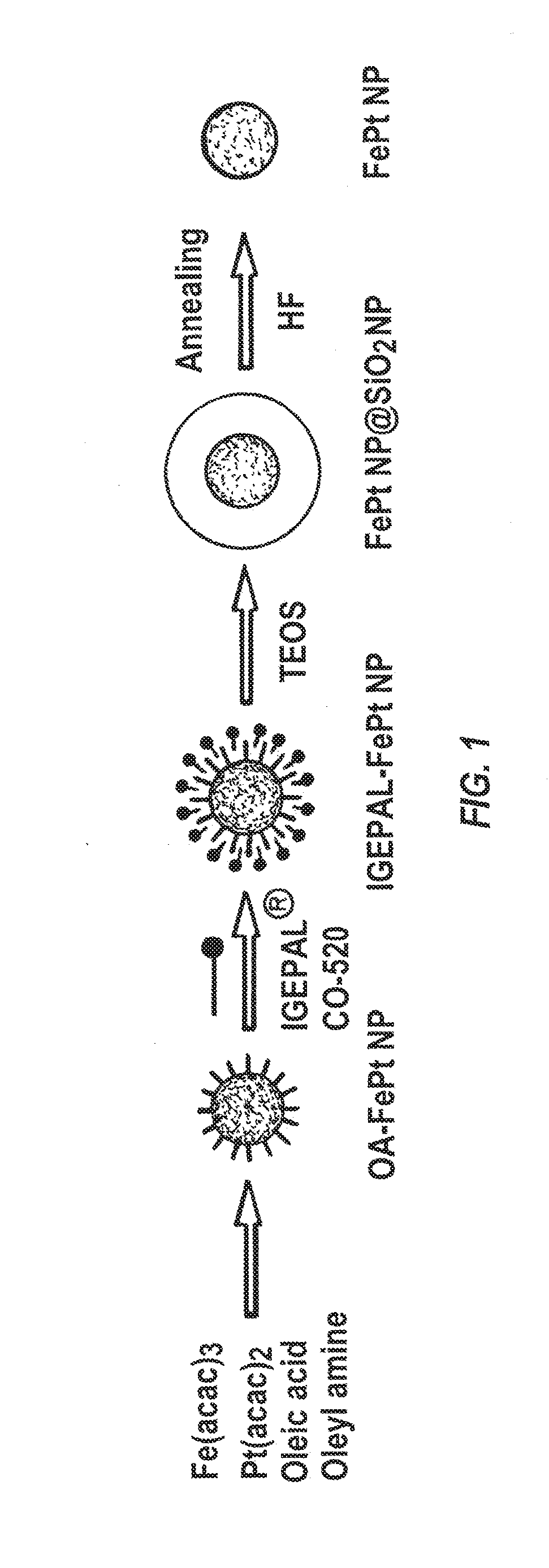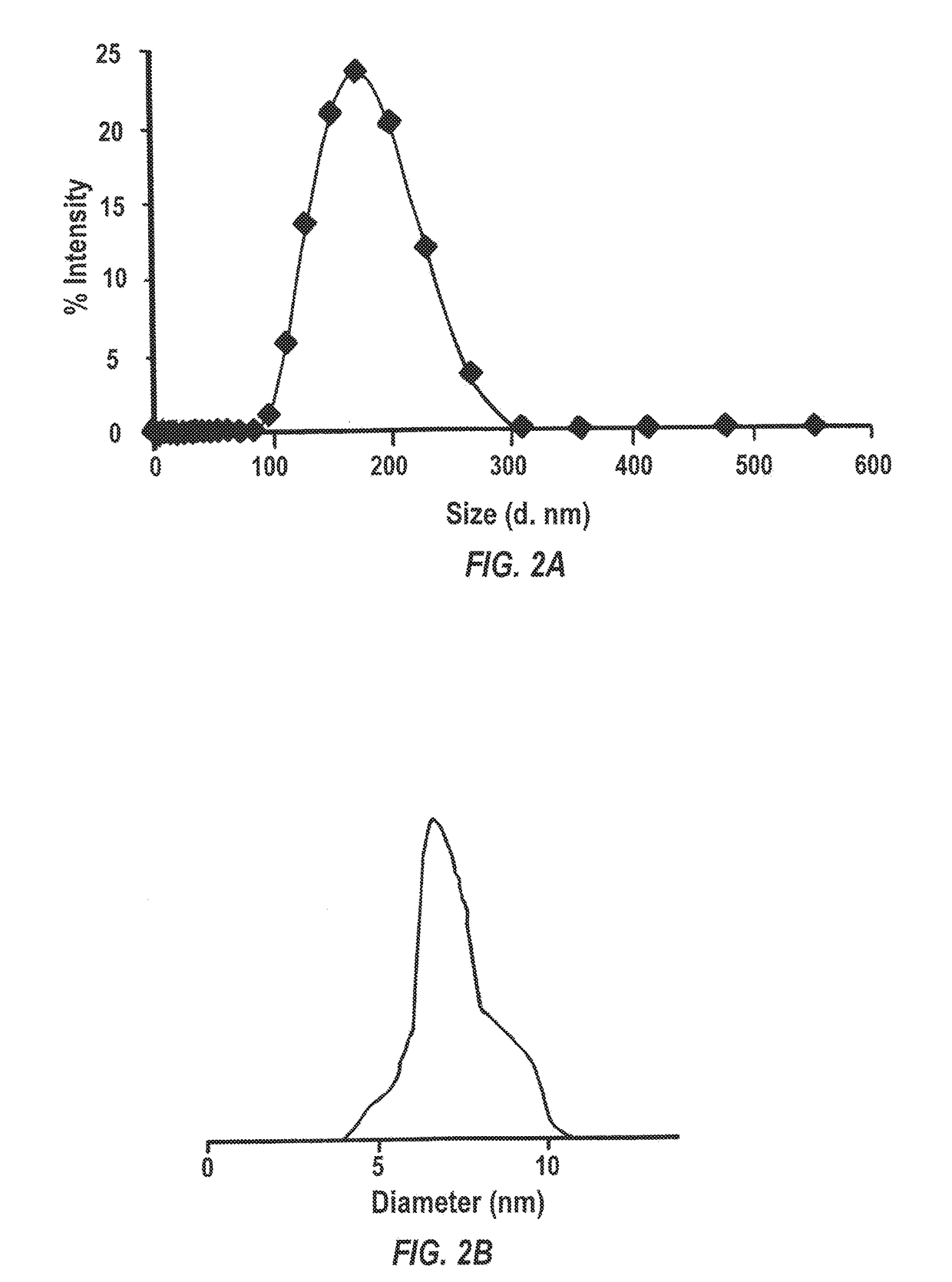Ferromagnetic particles bound to polymeric implants
- Summary
- Abstract
- Description
- Claims
- Application Information
AI Technical Summary
Benefits of technology
Problems solved by technology
Method used
Image
Examples
example 1
d Cells are Retained on Magnetized Stents In Vitro
Materials and Methods
Synthesis of Iron / Platinum Nanoparticles
[0169]The synthesis involves simultaneous chemical reduction of Pt(acac)2 and Fe(acac)3 by 1,2-hexadecanediol at high temperature (250° C.) in solution phase. The synthesis was handled under standard airless techniques in an argon atmosphere. The reagents were obtained from commercial sources and used without further purification. A mixture of 0.5 mmol of Pt(acac)2, 1.0 mmol of Fe(acac)3, and 1,2-hexadecanediol (5.0 mmol) was added to a 125 mL European flask containing a PTFE coated magnetic stir bar. Dioctyl ether (30 mL) was then transferred into the flask and the contents stirred while purging with Ar for 20 min at room temperature. The flask was then heated to 100° C. and held at 100° C. for 20 min. During this hold, 0.05 mmol (0.17 mL) of oleylamine and 0.05 mmol (0.16 mL) of oleic acid were injected into the flask while continuing the Ar purge. After the 20 min hold, ...
example 2
tion of Magnetized Cells in PLGA Particles
[0188]Cells (such as endothelial cells, macrophages or progenitor cells) can be made magnetically susceptible by intracellular incorporation of iron oxide or attachment to the surface.
Materials and Methods
[0189]To facilitate enhanced loading of iron-oxide in cells. PLGA particles are fabricated by the double emulsion method encapsulating a high concentration of iron oxide and a dye (Coumarin 6). PLGA particles encapsulating hydrophobic superparamagnetic iron oxide (SPIO) were prepared and surface-functionalized with avidin-palmitic acid. Briefly, PLGA (107 mg) and hydrophobic SPIO (26 mg) were dissolved in chloroform (2 mL) and then added drop-wise to a vortexing solution of 5% PVA (4 mL) and the resulting mixture was sonicated three times for 10 s at an amplitude of 38% (400 W). The mixture was then added drop-wise to 100 mL of 0.2% PVA and left stifling for 3h to evaporate the solvent. Particles were collected by centrifugation at 12,000 R...
example 3
Hydrogel Having Fe / Pt Particles Therein
Materials and Methods
[0196]The Fe / Pt nanoparticles discussed above can be tethered to the alginate backbone as shown in FIGS. 4A-4C.
[0197]A calcium sensitive magnetizable imageable hydrogel was fabricated using the CT / SPECT probe as reported in Crisone et. al. Bioconjug Chem. 2011 Sep. 21;22(9):1784-9. The probe was different in that an Fe / PT construct is used with iodine and chelator with pendant functional amines for conjugation to the alginate hydrogel backbone.
[0198]This is shown in FIG. 4A; FIG. 4B shows functionalization of the alginate backbone with the probe and schematic of aggregation upon calcium exposure.
[0199]The in situ-forming alginate hydrogel was injected into myocardial infarcts to provide a temporary scaffold which attenuates adverse cardiac remodeling and dysfunction.
Results
[0200]An absorbable biomaterial composed of calcium-crosslinked alginate solution, which displays low viscosity and, after injection into the infarct, un...
PUM
| Property | Measurement | Unit |
|---|---|---|
| Temperature | aaaaa | aaaaa |
| Fraction | aaaaa | aaaaa |
| Fraction | aaaaa | aaaaa |
Abstract
Description
Claims
Application Information
 Login to View More
Login to View More - R&D
- Intellectual Property
- Life Sciences
- Materials
- Tech Scout
- Unparalleled Data Quality
- Higher Quality Content
- 60% Fewer Hallucinations
Browse by: Latest US Patents, China's latest patents, Technical Efficacy Thesaurus, Application Domain, Technology Topic, Popular Technical Reports.
© 2025 PatSnap. All rights reserved.Legal|Privacy policy|Modern Slavery Act Transparency Statement|Sitemap|About US| Contact US: help@patsnap.com



